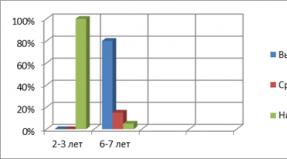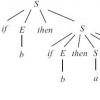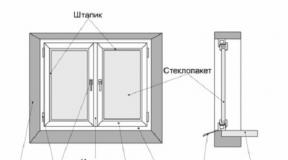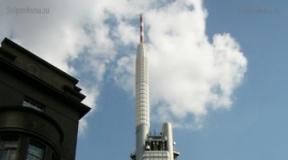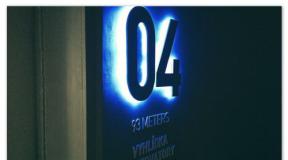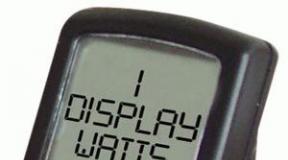Efferalgan is an excellent remedy for fever and pain. Efferalgan (Efferalgan) effervescent tablets Efferalgan adult instructions for use
Read this instruction carefully before you start taking / using this product.
This medicine is available without a prescription. For optimal results, it should be used in strict accordance with the instructions in the instructions.
Save the instructions as you may need them again.
If you have any questions, see your doctor.
INSTRUCTIONS FOR MEDICAL APPLICATION OF THE MEDICINAL PREPARATION EFFERALGAN® (EFFERALGAN®)
REGISTRATION NUMBER: P N011549 / 01-081215
TRADENAME: EFFERALGAN® (EFFERALGAN®)
INTERNATIONAL NON-PROPERTY NAME: paracetamol (paracetamol)
DOSAGE FORM: effervescent tablets
DESCRIPTION
Round, flat with beveled edges and scored on one side of the tablet, white. When dissolved in water, there is an intense evolution of gas bubbles.
COMPOSITION
1 effervescent tablet contains:
paracetamol 500 mg.
citric acid anhydrous 1114.00 mg, sodium bicarbonate 942.00 mg, sodium carbonate anhydrous 332.00 mg, sorbitol 300.00 mg, sodium saccharinate 7.00 mg, sodium docusate 0.227 mg, povidone 1.287 mg, sodium benzoate 60.606 mg.
PHARMACOTHERAPEUTIC GROUP: analgesic non-narcotic agent.
ATX CODE
PHARMACOLOGICAL PROPERTIES
Paracetamol (a derivative of paraaminophenol) has analgesic, antipyretic and mild anti-inflammatory effects.
The exact mechanism of the analgesic and antipyretic effects of paracetamol has not been established. Apparently, it includes central and peripheral components.
The drug blocks cyclooxygenase I and II mainly in the central nervous system, affecting the centers of pain and thermoregulation. In inflamed tissues, cellular peroxidases neutralize the effect of paracetamol on cyclooxygenase, which explains the almost complete absence of its anti-inflammatory effect. The drug does not have a negative effect on water-salt metabolism (sodium and water retention) and the gastrointestinal mucosa due to the lack of effect on the synthesis of prostaglandins in peripheral tissues.
Pharmacokinetics
Absorption
When taken orally, paracetamol is absorbed quickly and completely. Cmax (maximum plasma concentration of paracetamol) is achieved 10-60 minutes after administration.
Distribution
Paracetamol is rapidly distributed in all tissues. The concentration in blood, saliva and plasma is the same. Plasma protein binding is negligible.
Metabolism
Paracetamol is mainly metabolized in the liver. There are two main metabolic pathways with the formation of glucuronides and sulfates. The latter is mainly used if the accepted dose of paracetamol exceeds the therapeutic one.
A small amount of paracetamol is metabolized by the cytochrome P450 isoenzyme to form the intermediate N-acetylbenzoquinone imine, which under normal conditions undergoes rapid detoxification with glutathione and is excreted in the urine after binding with cysteine and mercaptopuric acid. However, with massive intoxication, the content of this toxic metabolite increases.
Withdrawal
It is carried out mainly with urine. 90% of the taken dose of paracetamol is excreted by the kidneys within 24 hours, mainly in the form of glucuronide (60 to 80%) and sulfate (20 to 30%). Less than 5% is displayed unchanged. The half-life is about 2 hours.
Pharmacokinetics in special groups patients
In severe renal impairment (creatinine clearance less than 30 ml / min), the excretion of paracetamol and its metabolites is delayed.
INDICATIONS FOR USE
Moderate or mild pain syndrome (headache, toothache, migraine pain, neuralgia, muscle pain, back pain, pain with injuries and burns, sore throat, painful menstruation);
- Increased body temperature with colds and other infectious and inflammatory diseases.
CONTRAINDICATIONS
Hypersensitivity to paracetamol, propacetamol hydrochloride (a prodrug of paracetamol) or any other component of the drug;
- Severe liver failure or decompensated liver disease in the acute stage.
- Deficiency of sucrase / isomaltase, fructose intolerance, glucose-galactose malabsorption.
- Pregnancy (I and III trimester) and lactation period.
- Childhood up to 12 years old.
CAREFULLY
Heavy renal failure(clearance, creatinine
DOSAGE AND APPLICATION
Inside. Dissolve the tablet in a glass of water (200 ml). Do not chew or swallow tablets. Usually 1-2 tablets are used 2-3 times a day at intervals of at least 4 hours.
Maximum single dose is 2 tablets (1 g), the maximum daily dose is 8 tablets (4 g), which corresponds to a single dose of 10-15 mg / kg of body weight, for a maximum daily dose of 75 mg / kg of body weight.
As a rule, there is no need to exceed the recommended daily dose of paracetamol equal to 3 g. The daily dose can be increased to the maximum (4 g) only in case of severe pain.
In case of impaired renal function, the time interval between doses of the drug should be at least 8 hours with a creatinine clearance of less than 10 ml / min, at least 6 hours - with a creatinine clearance of 10-50 ml / min.
In patients with chronic or compensated active liver diseases, especially accompanied by liver failure, in patients with chronic alcoholism, chronic insufficiency nutritional status (insufficient supply of glutathione in the liver), dehydration, or weighing less than 50 kg daily dose should not exceed 3 g, i.e. 6 tablets.
The drug should be used with caution in children and patients weighing less than 50 kg to exclude the risk of exceeding the recommended dose.
The dosage regimen in children over 12 years of age and weighing more than 43 kg is the same as in adults, with the interval preferably being 6 hours (strictly not less than 4 hours).
Duration of admission without consulting a doctor is no more than 5 days when prescribed as an anesthetic and 3 days as an antipyretic agent.
SIDE EFFECTS
When using the drug, the following were noted side effects(frequency not set):
Allergic reactions: hypersensitivity reactions, itchy skin, rash on the skin and mucous membranes (erythema or urticaria), Quincke's edema, exudative erythema multiforme (including Steven-Johnson syndrome), toxic epidermal necrolysis (Lyell's syndrome), anaphylactic shock, acute generalized exanthematous pustulosis.
From the side of the central and peripheral nervous system:(when taking high doses) dizziness, psychomotor agitation and disorientation in space and time.
From the digestive system: nausea, diarrhea, epigastric pain, increased activity of "liver" enzymes, usually without the development of jaundice, hepatonecrosis (dose-dependent effect).
From the endocrine system: hypoglycemia, up to hypoglycemic coma.
From the side of the hematopoietic organs: anemia (cyanosis), sulfohemaglobinemia, methemoglobinemia (shortness of breath, heart pain), hemolytic anemia(especially in patients with glucose-6-phosphate dehydrogenase deficiency), thrombocytopenia, neutropenia, leukopenia.
Others: decrease in blood pressure (as a symptom of anaphylaxis), change in prothrombin time and international normalized ratio (INR).
OVERDOSE
In case of an overdose, intoxication is possible, especially in children, patients with liver diseases (caused by chronic alcoholism), in patients with nutritional disorders, as well as in patients taking enzyme inducers, in which fulminant hepatitis, liver failure, cholestatic hepatitis, cytolytic hepatitis can develop, in the above cases - sometimes fatal.
The clinical picture of an acute overdose develops within 24 hours after taking paracetamol.
gastrointestinal disorders (nausea, vomiting, loss of appetite, discomfort in abdominal cavity and / or abdominal pain), pallor of the skin, sweating, malaise. With a single administration of 7.5 g or more to adults or more than 140 mg / kg to children, cytolysis of hepatocytes occurs with complete and irreversible liver necrosis, the development of liver failure, metabolic acidosis and encephalopathy, which can lead to coma and death. 12-48 hours after the introduction of paracetamol, there is an increase in the activity of "hepatic" transaminases, lactate dehydrogenase, bilirubin concentration and a decrease in prothrombin concentration.
Clinical symptoms of liver damage appear 1-2 days after drug overdose and reach a maximum on 3-4 days.
Immediate hospitalization;
Determination of the quantitative content of paracetamol in blood plasma before starting treatment as early as possible after an overdose;
Gastric lavage;
The introduction of donors of SH-groups and, precursors of the synthesis of glutathione - methionine and acetylcysteine - within 8 hours after an overdose. The need for additional therapeutic measures (further administration of methionine; intravenous administration of acetylcysteine) is determined depending on the concentration of paracetamol in the blood, as well as on the time elapsed after its administration;
Symptomatic treatment;
Liver tests should be performed at the beginning of treatment and then every 24 hours. In most cases, the activity of hepatic transaminases is normalized within 1-2 weeks. In very severe cases, a liver transplant may be required.
INTERACTION WITH OTHER DRUGS
Phenytoin reduces the effectiveness of paracetamol and increases the risk of developing hepatotoxicity. Patients taking phenytoin should avoid frequent use of paracetamol, especially in high doses.
Probenecid almost doubles the clearance of paracetamol, inhibiting the process of its conjugation with glucuronic acid. With the simultaneous appointment, consideration should be given to reducing the dose of paracetamol.
Care should be taken with the simultaneous use of paracetamol and inducers of liver microsomal enzymes (for example, ethanol, barbiturates, isoniazid, rifampicin, carbamazepine, anticoagulants, zidovudine, amoxicillin + clavulanic acid, phenylbutazone, tricyclic antidepressants).
Long-term simultaneous use of barbiturates reduces the effectiveness of paracetamol.
Salicylamide can increase the half-life of paracetamol.
INR should be monitored during and after the end of the simultaneous use of paracetamol (especially in high doses and / or for a long time) and coumarins (for example, warfarin), since paracetamol when taken at a dose of 4 g / day for at least 4 x days can enhance the effect of indirect anticoagulants and increase the risk of bleeding. If necessary, the dose of anticoagulants is adjusted.
SPECIAL INSTRUCTIONS
In order to avoid overdose, the content of paracetamol in other drugs that the patient takes simultaneously with Efferalgan® should be taken into account. Taking more paracetamol than recommended can cause severe liver damage.
With a continuing febrile syndrome against the background of the use of paracetamol for more than 3 days, and pain syndrome for more than 5 days, a doctor's consultation is required.
Taking Efferalgan® can distort laboratory tests when quantifying plasma glucose and uric acid.
To avoid toxic damage to the liver, paracetamol should not be combined with alcoholic beverages and also taken by persons prone to chronic alcohol consumption.
The risk of developing liver damage increases in patients with alcoholic hepatosis.
With prolonged use of the drug, it is necessary to control the picture of peripheral blood and functional state liver.
Paracetamol can cause serious skin reactions such as Steven-Johnson syndrome, toxic epidermal necrolysis, acute generalized exanthematous pustulosis, which can be fatal. At the first manifestation of a rash or other hypersensitivity reactions, the drug should be discontinued.
Also, the use of paracetamol should be discontinued if acute viral hepatitis is detected in the patient.
Efferalgan® contains 412.4 mg sodium per tablet, which should be taken into account by patients on a strict low-salt diet.
Since the drug contains sorbitol, it should not be used for sucrase / isomaltase deficiency, fructose intolerance, glucose-galactose malabsorption.
Impact on the ability to drive vehicles and work with mechanisms.
The effect on the ability to drive vehicles and work with mechanisms has not been studied.
If the patient experiences dizziness, psychomotor agitation and disorientation in space and time, it is not recommended for him to drive a car and other mechanisms during treatment with the drug.
RELEASE FORM
Effervescent tablets 500 mg.
4 tablets in a strip (aluminum foil / polyethylene). 4 strips together with instructions for use in a cardboard box.
STORAGE CONDITIONS
Store in a dry place at a temperature of 15-30 ° C.
Keep out of the reach of children!
SHELF LIFE
3 years.
Do not use after the expiration date.
TERMS OF RELEASE FROM PHARMACIES
Over the counter.
LEGAL ENTITY IN WHICH THE REGISTRATION CERTIFICATE IS ISSUED
UPSA SAS, France
3, rue Joseph Monier, 92500 Ruay-Malmaison, France
Photo of the drug
Latin name: Efferalgan
ATX code: N02BE01
Active substance: Paracetamol (Paracetamol)
Producer: Bristol-Myers Squibb (France)
Description up to date on: 26.01.18
Efferalgan is an analgesic, antipyretic drug.
Release form and composition
Available in the form of rectal suppositories, syrup and effervescent tablets.
The syrup is sold in polyethylene phthalate bottles (90 ml) in a cardboard box (1 bottle in each). The set includes a measuring spoon.
Rectal suppositories are produced in blisters (5 suppositories in each), placed in cardboard boxes of 2 pcs.
Effervescent tablets are available in strips (4 tablets each) and in cardboard boxes of 4 or 25 strips.
Indications for use
- as an analgesic drug for pain syndrome of moderate or low intensity (including dental, migraine and headache, neuralgia, sore throat, lower back, muscles, pain with burns and injuries, painful menstruation);
- as an antipyretic agent for childhood infections, flu, acute respiratory diseases, post-vaccination reactions and other infectious and inflammatory diseases against the background of which the body temperature rises.
Contraindications
- blood diseases;
- severe functional disorders of the kidneys, liver;
- recent bleeding or inflammation in the rectum (contraindication due to the route of administration - for suppositories);
- lack of the enzyme glucose-6-phosphate dehydrogenase;
- children's age up to 3 months (for 80 mg suppositories), up to 1 month (for syrup);
- hypersensitivity to paracetamol.
Contraindications to taking in the form of effervescent tablets are:
- lack of glucose-6-phosphate dehydrogenase;
- alcoholism;
- children under 15 years of age (body weight - up to 50 kg);
- pregnancy period (I and III trimesters) and breastfeeding(lactation);
- increased individual sensitivity to paracetamol or other auxiliary components of the drug.
The drug is prescribed with extreme caution for such pathologies:
- hepatic and / or renal failure;
- viral hepatitis;
- congenital hyperbilirubinemia (Rotor, Dubinin-Johnson and Gilbert syndromes);
- alcoholic liver damage;
- deficiency of glucose-6-phosphate dehydrogenase.
Instructions for use Efferalgan (method and dosage)
Syrup
It is taken orally, either after dilution (with juice, milk or water), or in pure form.
The average single dose of the drug is calculated based on the child's body weight and, as a rule, is 10-15 mg / kg body weight 3-4 times a day. The maximum daily dose should not exceed 60 mg / kg. The break between doses should be 4-6 hours. For dosing accuracy, you should use a measuring spoon, on which divisions are applied, corresponding to the baby's body weight.
- For a child with a body weight of 4 to 16 kg: collect the syrup in a measuring spoon to the mark corresponding to his body weight or to the mark that is closest in value to the weight of the baby.
- For a child with a body weight of 16 to 32 kg: collect the syrup in a measuring spoon up to the 10 kg mark, then again - until the total amount of the drug corresponds to the patient's body weight.
The duration of therapy is 5 days as a pain reliever and 3 days as an antipyretic agent. If it is necessary to take the drug for a longer period, a specialist consultation is necessary.
Rectal suppositories
Intended for rectal administration... After removing the candle from the packaging, it must be inserted into anus baby (preferably after a spontaneous bowel movement or a cleansing enema).
The average single dose of the drug depends on the child's body weight and, as a rule, is 10-15 mg / kg 3-4 times a day. The maximum daily dose should not exceed 60 mg / kg.
- Children from 3 to 5 months (with a body weight of 6-8 kg) - 1 suppository (80 mg).
- Children from 6 months to 3 years (with a body weight of 10-14 kg) - 1 suppository (150 mg).
- Children from 5 to 10 years old (weighing 20-30 kg) - 1 suppository (300 mg) 3-4 times a day with an interval of 4-6 hours.
Pills
They are taken orally, dissolved in 200 ml of drinking water. Usually appoint 1 - 2 table. 2-3 times a day, at least 4 hours apart. The maximum single dose is 2 tablets. (1 g), daily - 8 tab. (4 d).
In patients with functional impairment of the kidneys or liver and in elderly patients, the interval between doses should be at least 8 hours and the daily dose should be reduced. The duration of therapy is the same as in previous cases.
Side effects
Sometimes the use of Efferalgan causes side effects.
Common to all dosage forms:
- in some cases, attacks of nausea, vomiting, irritation of the rectal mucosa, allergic manifestations (urticaria, itching, Quincke's edema, skin rashes) are possible;
- extremely rarely - thrombocytopenia, leukopenia, anemia, methemoglobinemia, neutropenia;
- with prolonged use in high doses, there is a risk of nephrotoxic and hepatotoxic effects.
Additionally for syrup:
- stomach ache;
- diarrhea;
- decrease in blood pressure;
- allergies;
- an increase or decrease in the prothrombin index.
Additionally for effervescent tablets: with prolonged use in doses higher than recommended, the likelihood of functional disorders kidney and liver.
Overdose
Efferalgan overdose symptoms:
- nausea and vomiting;
- blanching of the skin;
- anorexia;
- hepatonecrosis.
In rare cases, fulminant development of liver failure was noted, in which the development of renal failure may be complications.
Treatment: in the first six hours, you need to wash the stomach. In 8-9 hours after an overdose, donors of SH-groups and precursors of the synthesis of glutathione - methionine should be introduced, after 12 hours - N-acetylcysteine.
Analogs
Do not make the decision to change the drug yourself, consult your doctor.
pharmachologic effect
Efferalgan is an antipyretic analgesic that has analgesic and antipyretic effects. Inhibits COX-1 and COX-2 mainly in the central nervous system, affecting the centers of pain and thermoregulation. In inflamed tissues, cellular peroxidases neutralize the effect of paracetamol on COX, which explains the almost complete absence of the anti-inflammatory effect.
It does not negatively affect water-salt metabolism and the gastrointestinal mucosa due to the lack of influence on the synthesis of prostaglandins in peripheral tissues. The risk of methemoglobin formation is negligible.
special instructions
- Common to all dosage forms: when using the drug for more than 5-7 days, monitoring of the functional state of the liver and the picture of peripheral blood is required.
- Additionally for effervescent tablets: in order to prevent toxic damage to the liver, the drug should not be combined with the use of alcoholic beverages, as well as used by patients prone to constant intake of alcohol.
- One Efferalgan tablet contains 412.4 mg of sodium, which should be taken into account by patients on a strict low-salt diet. Due to the fact that the drug contains sorbitol, it is not recommended to use it with poor adsorption of galactose and glucose, fructose intolerance, isomaltase deficiency.
- Additionally for syrup: the preparation contains paracetamol, therefore, to prevent exceeding the maximum daily dose, it should not be used simultaneously with other preparations containing this substance.
- If the drug is taken by children on a low-sugar diet or suffering from diabetes mellitus, it should be borne in mind that 1 ml of syrup contains 0.335 g of sugar.
During pregnancy and breastfeeding
Contraindicated during pregnancy and lactation.
Efferalgan is an antipyretic and pain relieving drug.
Release form and composition Efferalgan
Efferalgan is available in the form of baby syrup, rectal suppositories, effervescent tablets, the main active ingredient of which is paracetamol.
Excipients of Efferalgan are:
in syrup - sugar syrup, macrogol 6000, sodium saccharinate, potassium sorbate, citric acid, purified water, caramel-vanilla flavor;
in rectal suppositories - semi-synthetic glycerides;
in effervescent tablets - anhydrous sodium carbonate, anhydrous citric acid, sodium bicarbonate, soluble saccharin, sorbitol; povidone, sodium benzoate, docusate
Pharmacological action Efferalgan
Efferalgan has analgesic and antipyretic effects.
Paracetamol, contained in Efferalgan, blocks in the central nervous system COX-1 and COX-2, while acting on the centers of thermoregulation and pain. Cellular peroxidases in inflamed tissues neutralize the action of paracetamol, which is the reason that the drug has no anti-inflammatory effect.
The drug does not have a negative effect on the mucous membrane gastrointestinal tract and water-salt metabolism, due to the fact that there is no blocking effect on the synthesis of PG in peripheral tissues.
Indications for Efferalgan's use
According to the instructions Efferalgan is used:
in the form of syrup - for children aged 1 month-12 years (weight 4–32 kg);
in the form of suppositories 80 mg - for children aged 3 months-5 years (weight 6-8 kg);
in the form of suppositories 150 mg - for children aged 6 months-3 years (weight 10-14 kg);
in the form of suppositories 300 mg - for children aged 5-10 years (weight 20-30 kg)
in the following cases:
as an analgesic for moderate to mild pain (toothache, headache, neuralgia, muscle pain, burns and injuries);
as an antipyretic agent for influenza, acute respiratory diseases, post-vaccination reactions, childhood infections, and other infectious and inflammatory diseases that occur with fever.
Contraindications to Efferalgan's use
According to the instructions Efferalgan in the form of suppositories and syrup is contraindicated:
- in the presence of severe disorders in the work of the kidneys and liver;
- with a deficiency of the enzyme glucose-6-phosphate dehydrogenase;
- with a high sensitivity of the patient's body to paracetamol;
- with blood diseases;
- up to one month old (syrup), up to three months (suppositories 80 mg);
- if bleeding or inflammation has been observed in the rectum (suppositories).
Suppositories and syrup are used with caution when:
- violations in the work of the kidneys. The break between doses of drugs should be at least 8 hours;
- disorders in the work of the kidneys or liver with Gilbert's syndrome;
- diarrhea.
Effervescent tablets Efferalgan are contraindicated:
- with high sensitivity to paracetamol or other components included in the drug;
- with a deficiency of glucose-6-phosphate dehydrogenase;
- with alcoholism;
- during the first and third trimesters of pregnancy and during lactation;
- under the age of 15 (weight - not less than 50 kg).
Effervescent tablets Efferalgan are used with caution when:
- hepatic or renal failure;
- alcoholic liver damage;
- congenital hyperbilirubinemia;
- viral hepatitis;
as well as in old age.
Method of administration and dosage
Efferalgan syrup is taken orally. It can be diluted with water, juice, milk, or it can be consumed without dilution.
A single dose of syrup is determined by the weight of the child at the rate of 10-15 mg per kg of body weight. The syrup is taken 3-4 times a day. In this case, the daily dose of the drug should be no more than 60 mg per kg of body weight. The break between taking the drug is 4-6 hours.
Efferalgan suppositories are intended for rectal administration.
The suppository must be released from the packaging and, after emptying the intestines, inserted into the anus.
A single dose of Efferalgan suppositories is determined by the weight of the child at the rate of 10-15 mg per kg of body weight. Suppositories are administered 3-4 times a day. In this case, the daily dose of Efferalgan should not be more than 60 mg per kg of weight, and the interval between the administration of suppositories should be 4-6 hours.
Suppository dosage:
3-5 months (weight 6-8 kg) - 1 suppository 80 mg;
6 months-3 years (weight 10-14 kg) - 1 suppository 150 mg;
5-10 years (weight 20-30 kg) - 1 suppository 300 mg.
Effervescent tablets are taken orally, dissolved in 200 ml of water. As a rule, the drug is taken 2-3 times a day, 1-2 tablets, the interval is at least 4 hours.
As an analgesic agent, the drug in any form can be used for up to 5 days, as an antipyretic agent - up to 3 days.
Side effects of Efferalgan
According to reviews, Efferalgan in all forms can cause side effects in the form of: nausea, vomiting, irritation of the rectal mucosa, allergic reactions(skin rash, urticaria, itching, Quincke's edema), tenesmus, thrombocytopenia, anemia, leukopenia, methemoglobinemia, neutropenia.
When used for a long time in high doses, nephro- and hepatotoxic effects may occur.
The syrup can cause: diarrhea, a change in the prothrombin index, abdominal pain, a decrease in blood pressure, anaphylactic shock.
According to reviews, Efferalgan in the form of effervescent tablets is well tolerated in the doses recommended by the instructions. When used for a long time and in high doses, control of the peripheral blood picture is required.
Overdose
According to reviews of Efferalgan, an overdose of syrup and suppositories is manifested by: nausea, vomiting, epigastric pain, anorexia, sweating, pallor of the skin on the first day after administration.
140 mg of paracetamol per kg of body weight in children leads to the destruction of liver cells and irreversible hepatonecrosis, metabolic acidosis, liver failure, encephalopathy, which can cause coma and death.
Treatment of an overdose is to stop taking the drug and hospitalization.
An overdose of effervescent tablets is manifested by: pallor of the skin, nausea, vomiting, anorexia, hepatonecrosis.
In adults toxic effect develops after ingestion of more than 10-15 g of paracetamol.
For the treatment of an overdose in the first 6 hours, it is indicated: gastric lavage, donors of SH-groups and methionine.
Interaction with other drugs
When using Efferalgan simultaneously with:
- tricyclic antidepressants, barbiturates, flumecinol, anticonvulsants, phenylbutazone, ethanol, rifampicin - the risk of hepatotoxic action increases;
- salicylates - increases the risk of nephrotoxic action;
- chloramphenicol - the toxicity of chloramphenicol increases;
- probenecid - the clearance of paracetamol decreases;
- anticoagulants indirect action- their effect is enhanced;
- uricosuric drugs - their effect decreases;
Taking paracetamol can skew your blood uric acid and glucose test results.
Storage conditions Efferalgan
The drug must be stored in places with limited access for children at a temperature not exceeding 30 °.
Antipyretic drugs are always in the home medicine cabinet. An important point in taking any of them is not to resort to medication until the temperature indicator goes over 38 degrees. The body must learn to resist the virus itself and produce antibodies.
Efferalgan is one of the remedies that effectively and quickly fight high fever, are allowed for children and are not addictive. It is sold without a prescription, so you should follow the instructions when using it.
Antipyretic syrup EfferalganComposition and properties of Efferalgan syrup for children
Efferalgan UPSA is a modern antipyretic agent that allows you to quickly bring down high fever. It comes in three forms:
- Effervescent tablets. They are white, flat, round pills. There is a strip on one side. Sold in blister packs of 4. Upon contact with water, they begin to dissolve, while actively releasing gas bubbles.
- Syrup. It is dispensed in vials for 90 ml of solution. Usually, a special measuring spoon is included in the kit. The syrup itself is a viscous yellow-brown solution that smells like caramel and vanilla.
- Rectal suppositories. White, glossy and smooth. Released in blisters of 10 pieces.
Efferalgan in the form of a syrup is recommended for children. Its main active ingredient is paracetamol - 3 grams per 100 ml of product. The excipients included in the composition are as follows (their quantitative content in grams per 100 ml is indicated in brackets):
- sugar solution consisting of sucrose and water (50);
- macrogol 6000 (20);
- citric acid (0.107);
- sodium saccharinate (0.150);
- potassium sorbate (0.400);
- vanilla caramel flavor (0.200);
- purified water.
 In addition to syrup, Efferalgan is available in effervescent tablets and rectal suppositories.
In addition to syrup, Efferalgan is available in effervescent tablets and rectal suppositories. The pharmacological action of the drug can be described by three main properties:
- antipyretic;
- pain reliever;
- anti-inflammatory.
Paracetamol acts on the centers of pain and thermoregulation by blocking cyclooxygenase in the central nervous system (we recommend reading :). In the fabrics where it goes inflammatory process, its action is neutralized by cellular peroxidases, which explains their minimal anti-inflammatory effect.
After administration, the drug is rapidly absorbed from the gastrointestinal tract. The highest concentration of the substance in the blood plasma is observed after 10 - 60 minutes. In tissues and fluids, the distribution of the active ingredient is good. The drug is excreted through the kidneys with a half-life of 1 to 2 hours.
Indications for use
Efferalgan syrup is prescribed for children starting from one month of age and up to 12 years old with a body weight ranging from 4 to 32 kilograms. The main purpose of the drug is to relieve pain and bring down the temperature.
 Efferalgan is prescribed for children from one month of age to relieve pain and relieve fever.
Efferalgan is prescribed for children from one month of age to relieve pain and relieve fever.
As an anesthetic, the drug is prescribed for such types of pain of mild and moderate intensity as:
- muscular;
- head;
- dental;
- neuralgic in nature;
- traumatic;
- resulting from burns.
In the second quality, the solution is used for acute respiratory infections and infections that are provoked by the following pathogens:
- staphylococci and streptococci;
- rhinovirus, influenza A and B, parainfluenza;
- Staphylococcus aureus;
- colibacillus;
- Pneumococcus;
- herpes types 1 and 2.
 Efferalgan is used as an adjuvant after vaccination
Efferalgan is used as an adjuvant after vaccination When is the drug contraindicated?
The drug is contraindicated in case of high sensitivity to the constituents and in children who are not yet 1 month old. In addition to age restrictions and individual intolerance, Efferalgan is prohibited from using if a child has:
- malfunctions in the liver, which have turned into a severe form;
- lack of the enzyme glucose-6-phosphate dehydrogenase in the body;
- pathology of the circulatory system;
- chronic diseases of internal organs;
- impaired kidney function in a severe stage.
In addition to strict restrictions, there are situations when only the attending physician should prescribe a drug and control its intake, since the scheme will differ from the instructions attached to the package. This approach is useful for Gilbert's syndrome and kidney and liver problems with mild or medium severity.
Instructions for use
Children who do not yet know how to drink from a spoon are prescribed rectal suppositories with doses according to the child's age. In most cases, they resort to the help of a second, more popular form - syrup. The table below lists the dosages of Efferalgan recommended for children of different ages and with different body weights:
| Age, years | Body weight, kg | Dose, ml (mg) |
| 3-5 months | 6-8 | 3 (90) |
| 5-12 months | 8-10 | 4 (120) |
| 1-2 | 10-12 | 5 (150) |
| 2-3 | 12-14 | 6 (180) |
| 3-4 | 14-16 | 7 (210) |
| 4-6 | 16-20 | 8 (240) |
| 6-7 | 20-22 | 10 (300) |
| 7-8 | 22-24 | 11 (330) |
| 8-9 | 24-26 | 12 (360) |
| 9-10 | 26-28 | 13 (390) |
| 10-11 | 28-30 | 14 (420) |
| 11-12 | 30-32 | 15 (450) |
When calculating the dosage, you must focus on body weight. Also, in order to avoid an overdose, it is undesirable to use Efferalgan in conjunction with other drugs, which contain paracetamol. The course of treatment should not exceed 5-7 days. If a child is taking Efferalgan, during this period he should be provided with plenty of fluids, especially after taking the syrup.
 Efferalgan comes with a convenient measuring false, on which the divisions are applied (15 mg per 1 kg of body weight)
Efferalgan comes with a convenient measuring false, on which the divisions are applied (15 mg per 1 kg of body weight) Medicinal product should be stored in a dark place at temperatures up to 30 degrees and out of the reach of children. The shelf life is 3 years. From the moment the bottle is opened, the solution is usable for six months. It is forbidden to give a child a remedy if it has expired.
Possible side effects
Antipyretic and analgesic drug has established itself as effective remedy, which is well accepted by the child's body. However, this does not exclude the appearance of a negative reaction in children whose body cannot tolerate paracetamol or other components.
Among the side effects that may appear when taking Efferalgan, it should be noted:
- abdominal pain;
- bouts of nausea;
- vomit;
- diarrhea;
- irritation of the rectum;
- malfunctions of the digestive system;
- an allergic reaction that can appear in the form of hives, angioedema, skin rashes and itching.
 Efferalgan overdose may contribute to the development of urticaria
Efferalgan overdose may contribute to the development of urticaria In rare cases, there may be anemia, leukopenia, agranulocytosis, thrombocytopenia. With prolonged use, abdominal pain may become regular, and blood pressure- increased. There is a risk of anaphylactic shock.
The threat is posed by uncontrolled long-term use without observing the dosage. This causes changes in blood composition, methemoglobinemia and pancytopenia, produces hepatotoxic and nephrotoxic effects and leads to subsequent problems with the psychological health of the baby.
Consequences of an overdose
With regard to overdose in children, acute paracetamol poisoning can be identified by the onset of symptoms, including:
- blanching of the skin;
- lowering body temperature;
- anorexia;
- stomach pain;
- sweating
If, when the above signs occur, do not seek help from specialists, irreversible processes begin to occur in the cells, which are fraught with the development of acidosis, liver failure, hepatonecrosis, encephalopathy and coma.
After the drug was discontinued and the child was hospitalized, treatment is reduced to a number of activities, including:
- gastric lavage;
- taking enterosorbents (Polyphepan or activated carbon);
- intravenous injection of the antidote N-acetylcysteine;
- methionine course;
- symptomatic therapy.
The cost of the drug and analogues
One of the advantages of the antipyretic drug Efferalgan UPSA is its reasonable price. Despite its low cost, the product is characterized by high efficiency and safety when used correctly. Within the territory of Russian Federation a bottle of Efferalgan 90 mg can be purchased for 100 rubles. This price can vary within a range that depends on the city and pharmacy where the medicine is purchased.
Efferalgan is widely used in pediatric medicine due to its speed, safety for babies, minimum side effects and lack of addiction.
Despite all these advantages and availability, alternative drugs should be in mind. similar action... The pharmacological market provides a huge selection of all kinds medications with similar properties and characteristics, the main active ingredient which is paracetamol. Such drugs differ in the country where they were manufactured and in the auxiliary elements in the composition.
It is worth noting among the main analogues of Efferalgan.
Efferalgan tablets are rich white effervescent pills. The edges are rounded, there is a notch on one of the sides. It is necessary to dissolve in a glass of water, while gas bubbles begin to emerge intensively. Let's consider the features of the tool in more detail.
"Efferalgan": tablet composition
One piece contains 500 mg of active paracetamol, which is the main active ingredient. Among the auxiliary components are also present: sodium carbonate, bicarbonate, sodium docusate, anhydrous acid, povidone and sodium benzoate. It has a pronounced analgesic and antipyretic effect and belongs to analgesic-antipyretic drugs.
Medical indications
The use of Efferalgan tablets is based on their composition. Paracetamol actively eliminates pain and lowers body temperature, therefore, the indications for the appointment may be as follows:
- Mild to moderate pain. Helps with headaches, toothaches, neurological pains, and also relieves discomfort in the lower back and muscles. Helps relieve sore throat, burns and various injuries.
- Increased body temperature with infectious pathologies and colds.
It has been proven that the drug does not have a negative effect on water-salt metabolism. Due to the lack of an active effect on the synthesis of prostaglandins, there is no negative effect on the mucous membrane of the gastrointestinal tract.

Terms of use
A rather popular and demanded medicine is Efferalgan. Effervescent tablets have a clear instruction, where everything is thoroughly spelled out. So, the pill must be dissolved in a glass of warm water before use. The doctor may prescribe a dosage depending on the severity of the condition and the general well-being of the patient, however, "Efferalgan" in tablets, confirmation of this, is usually prescribed 2-3 times a day. You can take 1-2 pills at a time. In this case, the maximum dosage is recognized as 1 g active substance, which corresponds to two tablets. You can use no more than 4 g of paracetamol per day, which corresponds to 8 pills.

Directions for a special patient group
Tablets "Efferalgan" can be prescribed to the elderly, as well as to patients with impaired renal and / or liver function. However, the daily dosage is halved in this case, and the interval between the use of the drug should be at least 8 hours.
Duration of the course
Efferalgan tablets can be used for no more than 5 days. However, this rule applies to self-administration. The doctor can lengthen the therapeutic course. But it is important for the patient to know the basic rule of taking the medication. If the pills are used to relieve pain, then they are allowed to drink for three days. If the pain syndrome continues, it is necessary to consult a doctor for appropriate treatment. To relieve fever in infectious and colds, the medicine is approved for use for five days. Next, you should see a doctor if the temperature remains elevated.
What are the possible side effects?
Effective and safe with short-term use of "Efferalgan" effervescent tablets... The instructions for use still contain information about the possible negative consequences of taking. The most common reactions are allergic reactions. Patients sometimes complain of itching, skin rash during treatment. In rare cases, Quincke's edema is recorded, which threatens the health and life of the patient.
May also suffer circulatory system... The active substance of the drug affects hematopoiesis, therefore, anemia, methemoglobinemia and thrombocytopenia can be recorded. However, such symptoms often occur only with too long a course of treatment, regularly exceeding the recommended dosage and neglecting the advice of a doctor. Also among side effects it is worth highlighting the probable failures in the work of the liver and kidneys, therefore, patients with chronic diseases these organs are subject to observation and regular blood tests during therapy.
Feedback on use
Quickly eliminates high fever and fights pain syndrome "Efferalgan". Reviews of the pills are quite unambiguous, all patients confirm the effectiveness of the medicine, its pleasant taste and the duration of the therapeutic effect provided.
If you follow the doctor's recommendations or follow the instructions of the instructions, then usually the agent is well tolerated and does not cause persistent negative effects. Of course, there are also negative reviews in which people indicate the appearance of a rash, redness during treatment. However, such a reaction often becomes a consequence of exceeding the dosage or individual sensitivity to the incoming components. Also, some are not satisfied with the overestimated cost of the medication, because it is based on the well-known budget paracetamol. But, as practice shows, the usual pills have a less pronounced effect than "Efferalgan Oops" - effervescent tablets.

Strict contraindications
V high concentration contains paracetamol in an effervescent form of the drug. In addition, multiple auxiliary components are added to it, so the drug has its own restrictions on admission. Efferalgan tablets have the following contraindications to the appointment:
- age up to 15 years and weight less than 50 kg;
- 1st and 3rd trimester of gestation;
- delivered deficiency of glucose-6-phosphate dehydrogenase;
- period of breastfeeding;
- individual susceptibility to any component of the drug.
Patients with renal or hepatic impairment can use Efferalgan Upsa, but it must be done with caution and only with the permission of the attending physician. alcohol intoxication liver, the elderly and with a history of viral hepatitis.
Precautionary measures
Paracetamol has a toxic effect on the liver when combined with alcohol. Therefore, at the time of treatment, it is important to completely eliminate the consumption of alcohol. It is forbidden to prescribe medicine to patients suffering from chronic alcoholism. If alcoholic hepatosis exists, the risk of liver damage increases many times.
If it is necessary to use the medication for a long time, then clinical monitoring of the condition and functioning of the liver, as well as the delivery of tests to compare the picture of the peripheral blood system, will be required.
There are also warnings for patients on a low-salt diet. It is known that one dose of the drug contains more than 412 mg of sodium. Sorbitol is also present in the pills. Therefore, they are prohibited from taking to persons with fructose intolerance and low absorption of glucose and galactose.

Overdose and its consequences
Efferalgan tablets are a powerful drug. The instructions for use contain information on cases of overdose. In this case, following symptoms:
- pallor of the skin and mucous membranes;
- nausea turning into vomiting.
In this case, intoxication and the severity of necrosis directly depends on the excess of the level of the permissible number of tablets used. In adults, negative phenomena can already appear when using paracetamol at a dosage of more than 15 g at a time. At the same time, after 10 hours, excessive activity of the liver can be observed, and the expanded clinical picture with all the ensuing consequences - in 1-7 days.
However, sometimes the picture of an overdose manifests itself rapidly. Liver failure develops with lightning speed, which is often complemented by malfunctions of the kidneys.
First aid for overdose
It is important to provide first aid to the patient as early as possible. If symptoms were noticed within six hours after taking the pills, then it is necessary to rinse the stomach and introduce donors and precursors of glutathione synthesis in a hospital setting. Further actions are determined by the doctor based on the patient's condition and blood tests.
Possible combination with other drugs
It is known that ethanol, phenytoin, phenylbutazone and barbiturates enhance the oxidation of paracetamol in the liver, so drugs based on them can lead to the development of severe intoxication, even at minimal dosages, when taken simultaneously. At the same time, cimetidine and other oxidation inhibitors reduce the risk of adverse effects of paracetamol on the liver.
It is not advisable to take "Efferalgan" simultaneously with uricosuric medicines, because there is a significant decrease in the activity of the latter. If you use drugs based on ethanol, then there is a serious risk of developing acute pancreatitis.

Possible analogs
Efferalgan has many structural analogs, that is, containing paracetamol as its basis. However, each drug is designed for a specific list of diseases, it can be produced in different forms release and have incomparable contraindications. Therefore, the decision on the appointment of a particular remedy can only be made by a doctor based on the collected anamnesis. Among drugs with similar pharmacological action popular are:
- Tylenol;
- "Paracetamol";
- "Perfalgan";
- "Panadol";
- "Tsefekon D";
- "Ifimol";
- "Mexalen";
- "Aldolor";
- "Akamol Teva".
There are children's versions of drugs. On the basis of paracetamol, syrups are produced for children that have a pleasant taste, a convenient measuring spoon or syringe and a low concentration of the active substance.

Conclusion
The medicine is a first aid medicine and is available in pharmacies without a prescription. However, it is important to keep the effervescent tablets out of the reach of children's hands at all times. The storage temperature should not exceed 30 degrees. Choose a dry place out of direct sunlight.
Of course, Efferalgan can be used for a short time to relieve muscle, joint, throat and headache pain. It also quickly and permanently removes elevated temperature body, facilitating general state with colds and infectious pathologies. However, in severe cases and if long-term treatment is necessary, it is important to see a doctor. The instructions attached to the drug are offered for review, but may not always be a clear guide to action. If you have any doubts, you need to get advice from a specialist.
